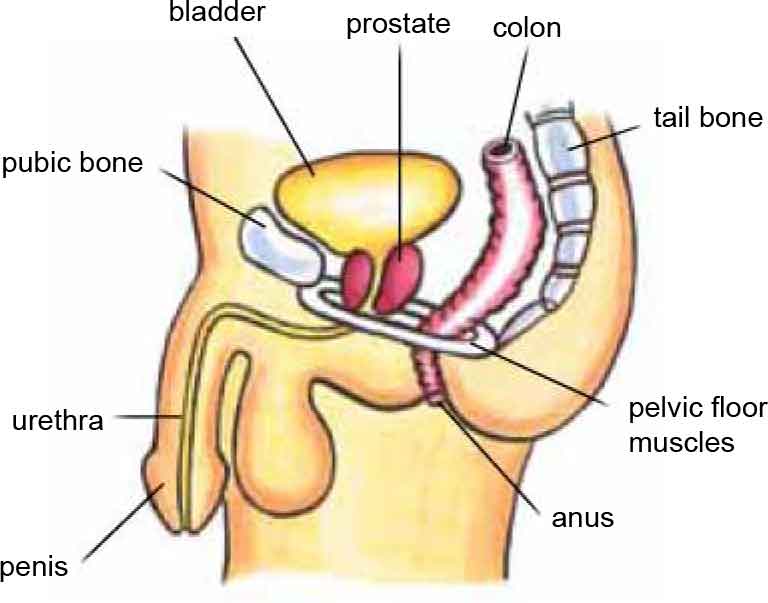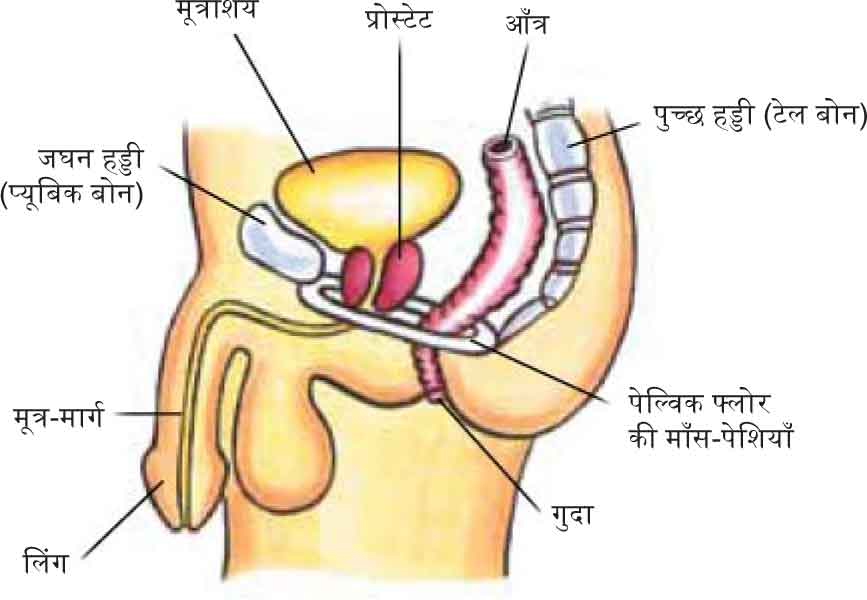|
The prostate is a gland that only men have. It is about the size of a walnut and sits below the neck of the bladder, surrounding the bladder outlet (the urethra). The prostate makes a milky fluid, which is part of semen and feeds the sperm. As men age, the prostate gland gets bigger. This happens over many years and for some men this can cause bladder problems. Poor bladder control can also happen due to other health issues. Men with poor bladder control can be upset and embarrassed by this problem. If you have changes in your bladder control, or concerns about your prostate gland, talk to your doctor or continence advisor. |
प्रोस्टेट एक ग्रंथि है जो केवल पुरुषों में ही होती है। यह एक अखरोट के आकार के बराबर होता है और यह मूत्राशय की ग्रीवा के नीचे मूत्राशय के निकास (मूत्रमार्ग) के इर्द-गिर्द मौजूद होता है। प्रोस्टेट एक दूधिया तरल पदार्थ बनाता है, जो वीर्य का एक अंश होता है और शुक्राणुओं के लिए भोजन के रूप में काम करता है। पुरुषों की उम्र बढ़ने के साथ-साथ प्रोस्टेट ग्रंथि का आकार बढ़ता जाता है। यह कई वर्षों की अवधि के दौरान होता है और कुछ पुरुषों के लिए यह मूत्राशय की समस्याएँ पैदा कर सकता है। मूत्राशय पर खराब नियंत्रण अन्य स्वास्थ्य संबंधी कारणों की वजह से भी हो सकता है। मूत्राशय के खराब नियंत्रण से ग्रस्त पुरुष इस समस्या से परेशान और शर्मिंदा हो सकते हैं। यदि आपकी मूत्राशय नियंत्रण क्षमता में कोई परिवर्तन होता है, या आप अपनी प्रोस्टेट ग्रंथि के बारे में चिंतित हैं, तो अपने डॉक्टर या कॉन्टिनेंस सलाहकार से बात करें। |
 |
 |
What are some common prostate problems?
|
कुछ आम प्रोस्टेट समस्याएँ क्या हैं?
|
How do I know if I have a prostate problem?If you have one or more of these issues, you may have a prostate problem:
Some of these problems may not be due to the prostate. For instance, some medicines may cause the bladder to store up urine. Your doctor or continence advisor can help you find the cause of your problem. |
मुझे यह कैसे पता चलेगा कि मुझे प्रोस्टेट की समस्या है?यदि आप इन मुद्दों में से एक या एक से अधिक मुद्दे से ग्रस्त हैं, तो आपको प्रोस्टेट समस्या हो सकती है:
हो सकता है कि इन समस्याओं में से कुछ समस्याएँ प्रोस्टेट के कारण न हों। उदाहरण के लिए, कुछ दवाइयाँ मूत्राशय में मूत्र को जमा करने का कारण हो सकती हैं। आपका डॉक्टर या कॉन्टिनेंस सलाहकार आपकी अपनी समस्या के कारणों का पता लगाने में मदद कर सकते हैं। |
How can my prostate cause bladder problemsBlocking of the urethra (the urine tube): As the prostate grows larger, it may block the bladder outlet and stop the bladder from emptying. In some cases, urine may get stored up until it starts to leak out. If this happens, see a doctor straight away. An overactive bladder can be caused by the bladder working extra hard to get past a blockage. An overactive bladder can tighten without your control, causing an urgent need to pass urine. After surgery to ease the blockage you may still have an urgent need to pass urine, and it could get worse for a few weeks, until the bladder goes back to normal. Surgery for prostate problems can damage the muscle and nerves of the bladder outlet in a few cases. This can cause poor bladder control. If it occurs it is almost always short-lived, though major surgery for prostate cancer can lead to long term bladder control problems. |
मेरे प्रोस्टेट से मूत्राशय की समस्याएँ कैसे पैदा हो सकती हैंमूत्रमार्ग (मूत्र नली) का अवरोधन: जैसे-जैसे प्रोस्टेट बढ़ता जाता है, वैसे-वैसे वह मूत्राशय के निकास को अवरुद्ध करता जाता है मूत्राशय को खाली होने से रोकता है। कुछ मामलों में मूत्र तब तक जमा हो सकती है जब तक कि यह रिसना शुरू न कर दे। यदि ऐसा होता है, तो तुरंत एक डॉक्टर से मिलें। अवरोध का सामना करने के लिए अतिरिक्त मेहनत करने वाला मूत्राशय एकअतिसक्रिय मूत्राशय हो सकता है। एक अतिसक्रिय मूत्राशय बिना आपके नियंत्रण के कस सकता है, जिससे कि आपको मूत्र-त्याग करने की तत्काल आवश्यकता महसूस हो सकती है। अवरोध को कम करने के लिए सर्जरी के बाद भी आपको मूत्र-त्याग करने की तत्काल आवश्यकता हो सकती है, और मूत्राशय के वापस सामान्य कार्य करने से पहले कुछ सप्ताहों के लिए स्थिति और खराब हो सकती है। कुछ मामलों में प्रोस्टेट समस्याओं के लिए सर्जरी मूत्राशय के निकास की माँस-पेशियों और तंत्रिकाओं को नुकसान पहुँचा सकती है। इससे मूत्राशय नियंत्रण खराब हो सकता है। यदि ऐसा होता है, तो यह बहुत कम अवधि के लिए ही होगा, हालाँकि प्रोस्टेट कैंसर के लिए बड़ीसर्जरी मूत्राशय नियंत्रण की दीर्घकालिक समस्याओं को जन्म दे सकती है। |
How can poor bladder control be treated?First, your doctor or continence advisor will want to look for the causes of your poor bladder control, such as prostate disease, infection, diabetes or some medicines. There are a few ways that poor bladder control due to prostate disease can be treated. 1. Check up with your doctor After a talk with your doctor, you may feel that you do not need any treatment. Poor bladder control can get better with time, or with simple changes to your daily habits. See the brochure 'Good Bladder Habits for Everyone'. 2. Medicines There are a number of medicines that can help with bladder control. Ask your doctor about these. 3. Prostate Surgery If your prostate is the problem, then surgery can remove all or part of the gland. The type of surgery will depend on the size of the prostate gland. 4. Bladder Training A program of bladder training can help the bladder to hold more urine without leaks or urgent feelings, even for those with an overactive bladder. 5. Pelvic Floor Muscle Training Pelvic floor muscle training builds up the muscles that control how well the bladder and bowel work. Learn how to train your muscles before surgery and start as soon as you can after surgery (See the leaflet “Pelvic Floor Muscle Training for Men”). 6. Continence Products There is a wide range of continence products to help cope with urine leaks (See the leaflet “Continence Products”). Make sure you know enough about what the problem is, what treatments there are, how well they work, and what might go wrong, so that you can choose the treatment that is best for you, with your doctor’s help. |
खराब मूत्राशय नियंत्रण का उपचार कैसे किया जा सकता है?सबसे पहले आपका डॉक्टर या कॉन्टिनेंस सलाहकार आपके खराब मूत्राशय नियंत्रण का कारण पता करना चाहेगा, जैसेकि प्रोस्टेट-रोग, संक्रमण, डायबेटीज़ या कुछ दवाइयाँ। ऐसे कुछ तरीके मौजूद हैं जिनसे प्रोस्टेट-रोग के कारण खराब मूत्राशय नियंत्रण का इलाज किया जा सकता है। 1. अपने चिकित्सक के साथ जाँच अपने डॉक्टर से बात करने के बाद हो सकता है कि आपको लगे कि आपको किसी भी उपचार की ज़रूरत नहीं है। खराब मूत्राशय नियंत्रण समय के साथ या अपनी दैनिक आदतों में साधारण से परिवर्तनों के साथ बेहतर हो सकता है (पत्रक "हर किसी के लिए अच्छी मूत्राशय आदतें" देखें)। 2. दवाइयाँ मूत्राशय पर नियंत्रण के लिए कई दवाइयाँ उपलब्ध हैं। इनके बारे में अपने चिकित्सक से पूछें। 3. प्रोस्टेट सर्जरी यदि आपका प्रोस्टेट ही समस्या है, तो सर्जरी के माध्यम से पूरी ग्रंथि या इसके एक भाग को निकाला जा सकता है। सर्जरी का प्रकार प्रोस्टेट ग्रंथि के आकार पर निर्भर करेगा। 4. मूत्राशय प्रशिक्षण एक मूत्राशय प्रशिक्षण का कार्यक्रम रिसावों या मूत्र-त्याग करने की तत्काल भावना के बिना अधिक मूत्र जमा करने में मूत्राशय की मदद कर सकता है, यहाँ तक कि अतिसक्रिय मूत्राशय वाले लोगों के लिए भी। 5. पेल्विक फ्लोर माँस-पेशी प्रशिक्षण पेल्विक फ्लोर माँस-पेशी प्रशिक्षण उन माँस-पेशियों को मजबूत बनाता है, जो मूत्राशय और आंत्र के अच्छी तरह से कार्य करने को नियंत्रित करती हैं। सर्जरी से पहले अपनी माँस-पेशियों को प्रशिक्षित करने और सर्जरी के बाद जल्दी से जल्दी प्रशिक्षण शुरू करना सीखें (पत्रक "पुरुषों के लिए पेल्विक फ्लोर माँस-पेशी प्रशिक्षण" देखें)। 6. कॉन्टिनेंस उत्पाद मूत्र रिसाव से निपटने में मदद करने के लिए अनेकानेक कॉन्टिनेंस उत्पाद उपलब्ध हैं (पत्रक "कॉन्टिनेंस उत्पाद" देखें)। यह सुनिश्चित करें कि आप इस बारे में पर्याप्त रूप से जानते/जानती हों कि समस्या क्या है, क्या उपचार उपलब्ध हैं, वे कितनी अच्छी तरह से काम करते हैं, और क्या गलत हो सकता है, जिससे कि आप अपने डॉक्टर की मदद से अपने लिए सबसे अच्छे इलाज का चयन कर सकें। |
Seek helpQualified nurses are available if you call the National Continence Helpline on 1800 33 00 66* (Monday to Friday, between 8.00am to 8.00pm Australian Eastern Standard Time) for free:
If you have difficulty speaking or understanding English you can access the Helpline through the free Telephone Interpreter Service on 13 14 50. The phone will be answered in English, so please name the language you speak and wait on the phone. You will be connected to an interpreter who speaks your language. Tell the interpreter you wish to call the National Continence Helpline on 1800 33 00 66. Wait on the phone to be connected and the interpreter will assist you to speak with a continence nurse advisor. All calls are confidential. * Calls from mobile telephones are charged at applicable rates. |
सहायता के लिए पूछेंयदि आप नि:शुल्क 1800 33 00 66* (सोमवार से शुक्रवार 8:00 बजे सुबह से लेकर 8:00 बजे रात के बीच, ऑस्ट्रेलियाई पूर्वी मानक समय) पर National Continence Helpline को कॉल करें, तो प्रशिक्षित नर्सें उपलब्ध हैं:
यदि आपको अंग्रेज़ी बोलने या समझने में कठिनाई होती है, तो आप 13 14 50 पर नि:शुल्क टेलीफोन दुभाषिया सेवा के माध्यम से हेल्पलाइन का उपयोग कर सकते/सकती हैं। फोन का उत्तर अंग्रेज़ी में दिया जाएगा, इसलिए जो भाषा आप बोलते/बोलती हैं, उसका नाम फोन पर बताएँ और प्रतीक्षा करें। आपको अपनी भाषा बोलने वाले दुभाषिए के साथ जोड़ा जाएगा। आप दुभाषिए को बताएँ कि आप National Continence Helpline को 1800 33 00 66 पर कॉल करना चाहते/चाहती हैं। फोन पर जुड़ने के लिए प्रतीक्षा करें और दुभाषिया आपको एक संयम नर्स सलाहकार के साथ बात करने में सहायता करेगा। सभी कॉलें गोपनीय रहती हैं। * मोबाइल फोन से की गई कॉलों का शुल्क लागू दरों पर लगता है। |
The Prostate And Bladder Problems in Hindi
रोस्टेट और मूत्राशय की समस्याएँ
Browse and download our factsheets in Hindi
Last Updated: Fri 30, Jul 2021
Last Reviewed: Tue 17, Mar 2020

